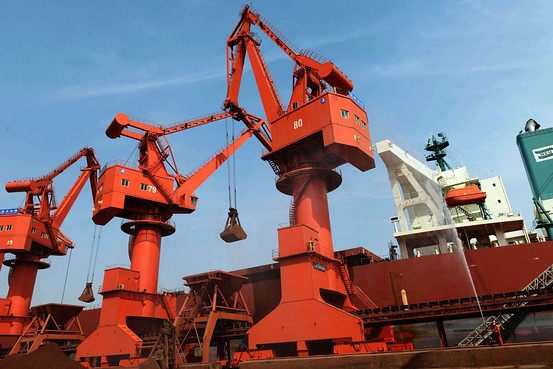Investors Fret Over Flood of Iron Ore
Post Date: 26 Jun 2014 Viewed: 315

Iron ore is unloaded in Qingdao, China. Agence France-Presse/Getty Images
Investors are cutting their exposure to iron ore as the industry faces a flood of new supply that has pushed prices for the steelmaking ingredient close to two-year lows.
Billions of dollars are being spent by resources companies on new iron-ore mines in countries from Australia to Brazil, aiming to meet Asia's appetite for steel used in everything from apartment buildings to cars. But many investors are concerned that demand isn't strong enough to soak up that supply, and that the industry could face a prolonged slump that could force shutdowns of higher-cost mines as well as layoffs.
"In previous years, we have seen a sharp selloff followed by a sharp rebound," said Neil Gregson, a fund manager at J.P. Morgan Asset Management overseeing about US$3.5 billion in natural-resources investments. "This time, we don't think there will be that sharp rebound."
The benchmark price of ore with 62% iron content imported through China's Tianjin port is down by about a third this year, as rising supplies from Australian mines gives steelmakers the upper hand in negotiations. Iron ore was trading at about US$93 a metric ton on Tuesday, after slipping as low as US$89 a ton last week to its weakest level since September 2012. Iron ore on Wednesday rose 0.4% to US$93.70 a ton.
In recent months, Mr. Gregson became a seller of the stocks of Australian iron-ore producers, including Rio Tinto Ltd. and Fortescue Metals Group Ltd. FMG.AU +1.15%The mining companies' share prices have fallen 14% and 26%, respectively, since the start of this year. He expects iron-ore prices to move in a US$10 band on either side of current levels.
Mr. Gregson isn't alone in taking a more bearish view. In recent weeks, companies including Deutsche Bank AG DBK.XE -0.95% and Commonwealth Bank of AustraliaCBA.AU +0.47% have slashed their forecasts for iron-ore prices. Morgan StanleyMS +0.62% lowered its price estimates by 21% in each of the next two years, to US$90 a ton in 2015 and US$87 a ton in 2016, saying it had underestimated the speed at which new mines were starting up.
About 1.3 billion tons of iron ore is traded by sea each year, with more than half of these shipments heading to China. Over the past decade, supply has largely kept pace with demand, in part because India has curbed output and exports as a result of environmental concerns.
However, UBS UBSN.VX +0.42% predicts the seaborne market will be awash with almost 74 million tons of surplus iron ore this year. By 2016, the seaborne market could be oversupplied by 267 million tons—or as much as Rio Tinto, the world's No. 2 iron-ore exporter, produced last year.
According to Tom Price, a Sydney-based analyst at UBS, the market is feeling the effects of an "epic, price-suppressing, Aussie-led supply surge."
Rio Tinto RIO.AU +0.49% is aiming to increase its Australian iron-ore output by a further 20% to 350 million tons within two years, while Fortescue completed a US$9.2 billion expansion of its mines in late March. These investments are already feeding through into sharply higher exports, with ports in the country's Pilbara region loading vessels at record rates.
"Over the past decade, virtually all new iron-ore supply was for seaborne export to China. That trend cannot continue with the headwinds the Chinese economy is now facing," said Adrian Martuccio, senior portfolio manager at Bell Asset Management, which oversees around US$5 billion. These headwinds include a probe into metal-backed financing that has prompted banks to withhold credit and customs officials to tighten checks.
Many investors also expect the pace of steel production in China to slow, as Beijing reins in capacity in the sector. "We saw steel demand flattening out or growing at a slower rate but, more importantly, we saw the supply situation was going to aggravate that demand slowdown," said Robert Hook, a Melbourne-based fund manager at SG Hiscock & Co., who has been selling mining shares in recent months.
Still, some brokers including New York-based Jefferies continue to recommend that investors buy shares of major miners such as BHP Billiton BLT.LN -1.12% and Rio Tinto due to increases in their dividends.
Mining companies are also moving to reduce costs and protect profits from a falling iron-ore price. BHP recently cut 100 jobs at the Perth headquarters of its iron-ore division, with a further 170 layoffs at the company's Mount Whaleback mine in the Pilbara region in Western Australia.
Rio Tinto is betting that its Pilbara mines will continue to be big money makers even at a lower iron-ore price, with high-cost mines in China most at risk from a sustained downturn.
"I think what they are saying is: 'We have good quality ore, and we are going to produce it, and if the lower-quality guys fall by the wayside then tough,'" said SG Hiscock's Mr. Hook.



